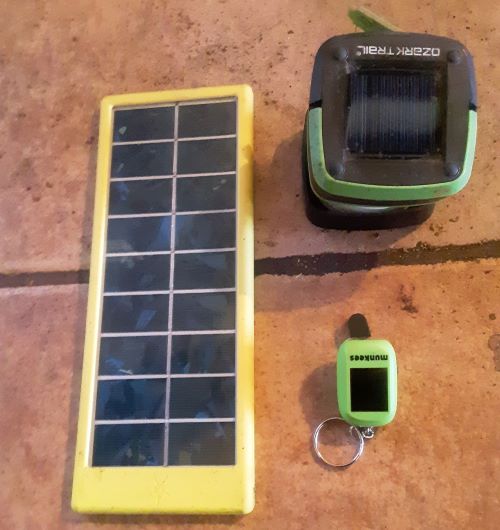
Hi there, K again. In this series of blog posts, I want to talk about photovoltaic systems–their components, different types available on the market, and real life limitations on their use if you want them to last. First we’ll talk about the different components of a photovoltaic system, and then in later posts how to put them all together. This will keep you from being overwhelmed by the entire installation process.
Considering efficiency and types of panels
I am not a certified solar installer, but unlike solar installers, I actually live solely on solar electricity, and am much more aware of its practical applications and real life limitations. I’ve lived with solar electricity now for about 20 years. I’ve installed my own systems at three different properties, and expanded my system with newer technology. I’ve taught friends how to install their systems, and done repairs to systems that were installed by solar installers.
In this blog post series, I want to talk to you about the basics of solar, without all the mathematical formulas or misleading theoretical applications.
First, let’s look at different types of solar panels. Constructed in different ways, they have different levels of efficiency.
Monocrystalline panels
You can identify these by the rounded corners on each of the cells. This is because they are made from a single silicon ingot. These have the highest efficiency of all the panels currently on the market, about 20 to 23%. If you have limited space these are probably the ones that you should be looking at. Unfortunately, the manufacturing process for these cells is quite complex, making this type of panel more expensive. But with all the attention going into green energy right now, companies are finding cheaper ways to manufacture these, so expect to see more of them in the future. Right now, these types of panels are often used for homes with limited roof space, for the military due to their efficiency, and for the International Space Station because they’re light-weight.
Polycrystalline panels
These can be identified by the straight corners and blue hue. These are manufactured by melting various silicon chips together, thus being simpler to make and cheaper to buy. They’re not as efficient as the monocrystalline panels, only getting about 15-18%. So you need more panels per kilowatt hour, and their efficiency is affected by high heat. These types of panels are used for homes where there’s plenty of roof or yard space. They’re also found in solar USB chargers (the yellow panel in the photo above).
Thin Film Panels
These don’t use silicon crystals at all. They’re made by laying down photovoltaic material in a thin layer. They have a very uniform appearance, without the divisions of the crystalline panels. If you’ve ever worked with a solar calculator, you’ve seen them before as a little black window pane that captures sunlight. These are the least expensive of all the panels, but also the most inefficient at 8-10%. These types of panels are ubiquitous, used for various small appliances like flashlights (the green object in the photo above), camping lanterns (the black object in the photo above), and calculators.
So the type of solar panel you select will depend on your available space, budget, and application. There’s a lot more to consider when setting up your system, so keep an eye out for more posts on photovoltaic systems.
Next blog post: Part 2: Photovoltaic systems– types of solar controllers (by K)
